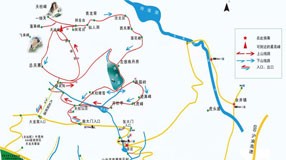
April 22, 2024 is the 55th World Earth Day, and the theme of this year's Earth Day is "Planet vs. Plastics". In order to thoroughly study and implement the spirit of the 20th National Congress of the Communist Party of China, publicize Xi Jinping Thought on Ecological Civilization, guide the whole society to establish the concept of ecological civilization of "respecting nature, conforming to nature, and protecting nature", promote the construction of beautiful Qianshan, and jointly build an earth home where man and nature coexist in harmony, Tianzhushan Global Geopark, Anqing Qianshan Ecological Environment Branch and Qianshan Pailou Central Primary School jointly carried out the 55th "World Earth Day" and the 5th Asia-Pacific Geopark Week Science Popularization Campaign. In the form of museum-school cooperation and joint construction and common benefit, Tianzhushan Geopark will give full play to the social education function of the museum and jointly build a "second classroom" for popular science education.
More
Details
Recently, two paleontological fossils newly found in Tianzhushan UNESCO Global Geopark were named. Tianzhushan Geopark actively uses scientific research results as the foundation for science popularization and promotes the deep integration of science popularization and scientific research.

Paleontologists named a paleontological fossil found in Qianshan, Qianshanosuchus youngi, with the genus name referring to Qianshan, where it was found, and the species name paying tribute to the Paleontologist Yang Zhongjian, pioneer and founder of vertebrate paleontology in China, and the researcher of the first fossil, Protoalligator huiningensis, found in Qianshan Basin.
The Qianshanosuchus lived in the early Paleocene, and the fossil was unearthed from the lower part of the upper section of Wanghudun Formation, and the holotype specimen contains an almost complete skull. The Qianshanosuchus belongs to the family Crocodyloidea and shows a distinctly immature skull. Compared to other crocodilians, it has a well-developed maxillary canal to accommodate the trigeminal nerve and a distinct anterior-posteriorly oriented lateral crest on the surangulare. Phylogenetic analysis shows that it belongs to the basal family Crocodyloidea, closer to the basal stem than Albertosuchus and other Late Cretaceous North American taxa.
The presence of Qianshanosuchus proves that the family Crocodyloidea came to Asia to branch out in the early Paleocene, and given that it was in a more basal position than the Albertosuchus, its ancestors were diverging from North American taxa at least by the Maastrichtian (70.6 ± 0.6 – 65.8 ± 0.3 Ma), and the family Crocodyloidea probably came to Asia via the land bridge of the Bering Strait during the Late Cretaceous.
In Tianzhushan UGGp, two other reptile fossils from the same period, Wanosuchus atresus and Protoalligator huiningensis, have been discovered. Tianzhushan Geopark uses these crocodilian fossils as comparative material to educate young students about the differences between the Crocodilidae and Alligatoridae families, and also compiles information on the characteristics, strata and exhibits of these crocodilians in the Science Reading Qianshan Fauna.

At the same time, paleontologists excavated two dinosaur eggs filled with calcite crystals in Qianshan Basin. These spherical dinosaur egg fossils are thought to belong to a previously unknown species of dinosaur and have been named Shixingoolithus qianshanensis. The researchers published their findings in the Journal of Palaeontology: the eggs were "approximately spherical", one egg was partially broken with inner surface covered by layers of crystals. The discovery of this fossil provides new palaeontological information on the palaeoenvironment of Qianshan Basin in Late Cretaceous. Tianzhushan Geopark has displayed the type specimen of Shixingoolithus qianshanensis in Tianzhushan Geopark Museum, provided information panels with name and characteristics, describing the reason calcite occurs in dinosaur egg fossils.

Scientific research and science popularization are mutually dependent and promote each other. Tianzhushan UGGp strongly supports universities and scientific research institutions to conduct scientific research in the geopark, and at the same time, creates a platform for scientific communication, which plays an important role in improving the quality of public science education.






















































